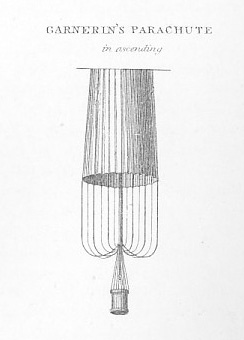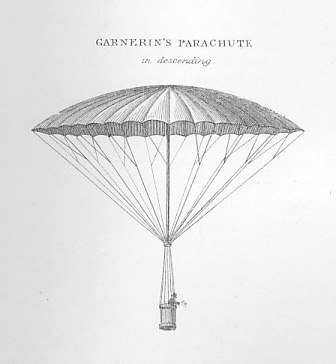1902 Encyclopedia > Aeronautics > Parachutes: History of their Development. Blanchard. Garnerin. Kuparento.
Aeronautics
(Part 39)
Parachutes: History of their Development. Blanchard. Garnerin. Kuparento.
The principle of the parachute is so simple that the idea must have occurred to persons in all ages. Father Loubere in his History of Siam, published two centuries ago, tells of a person who frequently diverted the court by the prodigious leaps he used to take, having two parachutes or umbrellas fastened to his girdle. In 1783 a certain M. le Normand practically demonstrated the efficiency of a parachute by descending from a high house at Lyons; but he merely regarded it as a useful means whereby to escape from fire. To Blanchard is due the idea of using it as an adjunct to the balloons. As early as 1785 he had constructed a parachute, to which was attached a basket. In this he placed a dog, which descended safely to the ground when the parachute was released from a balloon at a considerable elevation. It is stated that he descended himself from a balloon in a parachute in 1793; but owing to some defect in its construction, he fell too rapidly, and broke his leg.
André Jacques Garnerin was the first person who successfully descended from a balloon in a parachute, and he repeated this experiment so often that he may be said to have first demonstrated the practicability of using the machine; and, in fact, that he invented it in a practical and suitable form. In 1793 Garnerin had been taken prisoner at Marchiennes, and he was confined for between two and three years in the fortress of Bude, in Hungary. While in captivity he elaborated in his mind the means of descending from a balloon by means of a parachute; and on October 22, 1797, he made his first public experiment. He ascended from the park of Moncau at Paris, and when at the height of about 1 x mile he released the parachute, which was attached to the balloon in place of a car; the balloon, relieved suddenly of so great a weight, rose very rapidly till it burst, while the parachute ddescended very fast, making violent oscillations all the way. Garnerin, however, reached the earth in safety upon the pain of Monceau. In 1802 Garnerin came to England and made a good many ascents in all parts of the country, many of which excited much enthusiasm, as can be seen from the contemporary accounts; and on September 21, 1802, he repeated his parachute experiment in England .

Garnerin's Parachute (while ascending)

Garnerin's Parachute (while descending)
The parachute was done-shaped, and bore a resemblance to a large umbrella. The case or dome was made of white canvas, and was 23 feet in diameter. At the top was a truck or round piece of wood 10 inches in diameter, with a hole in its center, fastened to the canvass by 32 short pieces of tape. The parachute was suspended from a hoop attached to the netting of the balloon, and below the parachute was placed a cylindrical basket, 4 feet high and 2 x feet in diamter, which contained the aeronaut. The ascent took place at about six o'clock from North Street, London; and, at a height of about (it is believed) 8000 feet, Garnerin separated the parachute from the balloon. For a few seconds his fate seemed certain, as the parachute retained the collapsed state in which it had originally ascended, and fell very rapidly. It suddenly, however, expanded, and the rapidity of its descent was at once checked, but the oscillations were so violent that the car, which was suspended 20 feet below, was sometimes on a level with the rest of the apparatus. Some accounts state that these oscillations increased, others that they decreased as the parachute descended, and the latter seems most probable. It came to the ground in a field at the back of St Pancras church, the descent having occupied rather more than ten minutes. Garnerin was hurt a little by the violence with which the basket containing him struck the earth; but a few cuts and a slight nausea represented all the ill effects of his fall. He made, certainly, one other descent in a similar was (as that just described is stated to have been his third), and we believe several others on the Continent, but this was the only on he effected in England.
Jordaki Kuparento, a Polish aeronaut, is the only person who ever made any real use a parachute. He ascended from Warsaw on July 24, 1808, in a fire-balloon, which, at a considerable elevation, took fire; but being provided with a parachute, he was enabled to effect his descent in safety.
Read the rest of this article:
Aeronautics - Table of Contents
|

